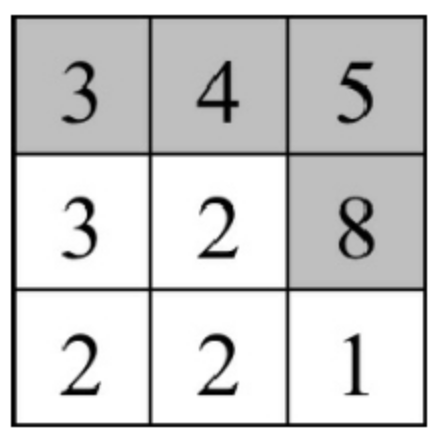面试算法112:最长递增路径
发布时间:2024年01月11日
题目
输入一个整数矩阵,请求最长递增路径的长度。矩阵中的路径沿着上、下、左、右4个方向前行。例如,图中矩阵的最长递增路径的长度为4,其中一条最长的递增路径为3→4→5→8,如阴影部分所示。

分析
由于需要搜索图中的所有节点才能确定最长递增路径的长度,因此这也是一个关于图搜索的问题。解决图搜索通常用广度优先搜索和深度优先搜索这两种不同的方法。这个问题中的路径是非常关键的信息,而深度优先搜索能够很方便地记录搜索的路径,因此深度优先搜索更适合这个问题。
因为不知道从哪个节点开始的递增路径是最长的,所以试着找出从矩阵的每个数字出发的最长递增路径的长度,通过比较可以得出整个矩阵中的最长递增路径的长度。
解
public class Test {
public static void main(String[] args) {
int[][] matrix = {{3, 4, 5}, {3, 2, 8}, {2, 2, 1}};
int result = longestIncreasingPath(matrix);
System.out.println(result);
}
public static int longestIncreasingPath(int[][] matrix) {
int rows = matrix.length;
int cols = matrix[0].length;
if (rows == 0 || cols == 0) {
return 0;
}
int[][] lengths = new int[rows][cols];
int longest = 0;
for (int i = 0; i < rows; i++) {
for (int j = 0; j < cols; j++) {
int length = dfs(matrix, lengths, i, j);
longest = Math.max(longest, length);
}
}
return longest;
}
private static int dfs(int[][] matrix, int[][] lengths, int i, int j) {
if (lengths[i][j] != 0) {
return lengths[i][j];
}
int rows = matrix.length;
int cols = matrix[0].length;
int[][] dirs = {{-1, 0}, {1, 0}, {0, -1}, {0, 1}};
int length = 1;
for (int[] dir : dirs) {
int r = i + dir[0];
int c = j + dir[1];
if (r >= 0 && r < rows && c >= 0 && c < cols && matrix[r][c] > matrix[i][j]) {
int path = dfs(matrix, lengths, r, c);
length = Math.max(path + 1, length);
}
}
lengths[i][j] = length;
return length;
}
}
文章来源:https://blog.csdn.net/GoGleTech/article/details/135529283
本文来自互联网用户投稿,该文观点仅代表作者本人,不代表本站立场。本站仅提供信息存储空间服务,不拥有所有权,不承担相关法律责任。 如若内容造成侵权/违法违规/事实不符,请联系我的编程经验分享网邮箱:chenni525@qq.com进行投诉反馈,一经查实,立即删除!
本文来自互联网用户投稿,该文观点仅代表作者本人,不代表本站立场。本站仅提供信息存储空间服务,不拥有所有权,不承担相关法律责任。 如若内容造成侵权/违法违规/事实不符,请联系我的编程经验分享网邮箱:chenni525@qq.com进行投诉反馈,一经查实,立即删除!
最新文章
- Python教程
- 深入理解 MySQL 中的 HAVING 关键字和聚合函数
- Qt之QChar编码(1)
- MyBatis入门基础篇
- 用Python脚本实现FFmpeg批量转换
- CSS水平垂直居中(最常见的三种方案flex、grid、absolute)
- MIT_线性代数笔记:第 18 讲 行列式及其性质
- js 粘贴功能
- 【开源】基于Vue和SpringBoot的高校学院网站
- 实现用户注册功能
- Django全文搜索
- 在Docker中安装Tomact
- Phantomjs+Java+springboot实现后端截图
- vite的初步尝试
- PSIM仿真DSP28335ADC功能并使用SCI串口模块输出曲线